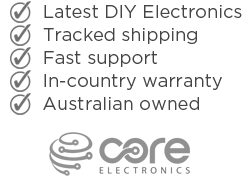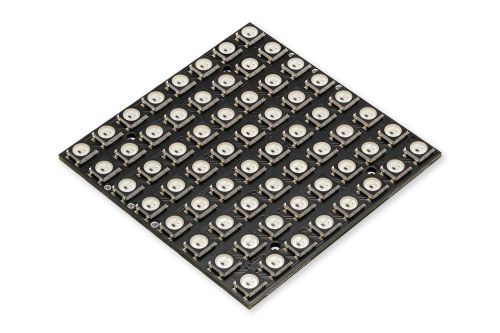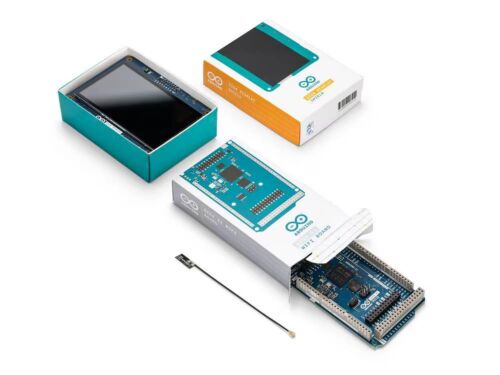We have a versatile range of DC-DC regulators and converters available, from Breadboard power supplies, Buck/Boost converters and everything in between.
Step-Up/Step-Down
These step-up/step-down converters are a perfect way to regulate a DC voltage for your project's needs. Click on a product for datasheets and more.
- Pololu 3.3V Step-Up/Step-Down Voltage Regulator S7V8F3SKU: POLOLU-2122 Brand: PololuThe S7V8F3 switching step-up/step-down regulator efficiently produces a fixed 3.3 V output from input voltages between 2.7 V and 11.8 V. Its ability to convert both higher and lower input voltages makes it useful for applications where the power supply voltage can vary greatly, as with batteries that start above but discharge below the regulated voltage. The compact (0.45″ × 0.65″) module has a typical efficiency of over 90% and can deliver 500 mA to 1 A across most of the input voltage range.
- Pololu 5V Step-Up/Step-Down Voltage Regulator S7V8F5SKU: POLOLU-2123 Brand: PololuThe S7V8F5 switching step-up/step-down regulator efficiently produces a fixed 5 V output from input voltages between 2.7 V and 11.8 V. Its ability to convert both higher and lower input voltages makes it useful for applications where the power supply voltage can vary greatly, as with batteries that start above but discharge below the regulated voltage. The compact (0.45″ × 0.65″) module has a typical efficiency of over 90% and can deliver 500 mA to 1 A across most of the input voltage range.
- Pololu 5V Step-Up/Step-Down Voltage Regulator S7V7F5SKU: POLOLU-2119 Brand: PololuThe S7V7F5 switching step-up/step-down regulator efficiently produces 5 V from input voltages between 2.7 V and 11.8 V. Its ability to convert both higher and lower input voltages makes it useful for applications where the power supply voltage can vary greatly, as with batteries that start above but discharge below 5 V. The very compact (0.35″ × 0.475″) module has a typical efficiency of over 90% and can supply up to 1 A when stepping down and about 500 mA when stepping up.
- Pololu 24V Step-Up/Step-Down Voltage Regulator S18V20F24SKU: POLOLU-2582 Brand: PololuThis powerful step-up/step-down regulator efficiently produces a fixed 24 V output from input voltages between 3 V and 30 V while allowing a typical output current of up to 2 A when the input voltage is close to the output voltage and offering typical efficiencies of 80% to 90%.
- 150W DC-DC Converter 13.8V @ 10ASKU: CE07298 Brand: Core ElectronicsThis is a waterproof DC-DC converter. With 8-40V DC input, it converts to 13.8V@10A which is an ideal supply for automotive components.$44.95 AUD, inc GSTDelivered by Dec 31st
Step-Up
These step-up (boost) converters are the perfect way to increase a DC voltage up to something suitable for your project's needs.
- Pololu 5V Step-Up Voltage Regulator U1V10F5SKU: POLOLU-2564 Brand: PololuThis tiny (0.35″×0.45″) U1V10F5 switching step-up (or boost) voltage regulator efficiently generates 5 V from input voltages as low as 0.5 V. Unlike most boost regulators, the U1V10F5 automatically switches to a linear down-regulation mode when the input voltage exceeds the output. The pins have a 0.1″ spacing, making this board compatible with standard solderless breadboards and perfboards.
- Pololu 3.3V Step-Up Voltage Regulator U1V10F3SKU: POLOLU-2563 Brand: PololuThis tiny (0.35″×0.45″) U1V10F3 switching step-up (or boost) voltage regulator efficiently generates 3.3 V from input voltages as low as 0.5 V. Unlike most boost regulators, the U1V10F3 automatically switches to a linear down-regulation mode when the input voltage exceeds the output. The pins have a 0.1″ spacing, making this board compatible with standard solderless breadboards and perfboards.
Step-Down
These step-down (Buck) converters are a perfect way to decrease a DC voltage to something suitable for your project's needs.
- Pololu 5V, 500mA Step-Down Voltage Regulator D24V5F5SKU: POLOLU-2843 Brand: PololuThe compact (0.4″ × 0.5″) D24V5F5 synchronous buck voltage regulator takes an input voltage of up to 36 V and efficiently reduces it to 5 V while allowing for a maximum output current of 500 mA. This regulator offers typical efficiencies between 85% and 90% and has a very low dropout, so it can be used with input voltages as low as a few hundred millivolts above 5 V. The pins have a 0.1″ spacing, making this board compatible with standard solderless breadboards and perfboards.
- Pololu 5V, 5A Step-Down Voltage Regulator D24V50F5SKU: POLOLU-2851 Brand: PololuThis small synchronous switching step-down (or buck) regulator takes an input voltage of up to 38 V and efficiently reduces it to 5 V. The board measures only 0.7″ × 0.8″, but it allows a typical continuous output current of up to 5 A. Typical efficiencies of 85% to 95% make this regulator well suited for high-power applications like powering motors or servos. High efficiencies are maintained at light loads by dynamically changing the switching frequency, and an optional shutdown pin enables a low-power state with a current draw of a few hundred microamps.
- Pololu 5V, 1A Step-Down Voltage Regulator D24V10F5SKU: POLOLU-2831 Brand: PololuThe compact (0.5″ × 0.7″) D24V10F5 synchronous buck voltage regulator takes an input voltage of up to 36 V and efficiently reduces it to 5 V while allowing for a maximum output current of 1 A.
- Pololu 5V, 600mA Step-Down Voltage Regulator D24V6F5SKU: POLOLU-2107 Brand: PololuThe compact (0.4″ × 0.5″) D24V6F5 switching step-down (or buck) voltage regulator takes an input voltage between 7 V and 42 V and efficiently reduces it to 5 V while allowing for a maximum output current of 600 mA. The pins have a 0.1″ spacing, making this board compatible with standard solderless breadboards and perfboards.
- Pololu 5V, 2.5A Step-Down Voltage Regulator D24V25F5SKU: POLOLU-2850 Brand: PololuThis small synchronous switching step-down (or buck) regulator takes an input voltage of up to 38 V and efficiently reduces it to 5 V. The board measures only 0.7″ × 0.7″, but it allows a typical continuous output current of up to 2.5 A. Typical efficiencies of 85% to 95% make this regulator well suited for powering moderate loads like sensors or small motors. High efficiencies are maintained at light loads by dynamically changing the switching frequency, and an optional shutdown pin enables a low-power state with a current draw of a few hundred microamps.
- Pololu 9V, 15A Step-Down Voltage Regulator D24V150F9SKU: POLOLU-2884 Brand: PololuThis synchronous switching step-down (or buck) regulator takes an input voltage of up to 40 V and efficiently reduces it to 9 V with an available output current of around 15 A. Typical efficiencies of 80% to 95% along with its high current capabilities make this regulator well suited for powering large loads. The regulator features reverse voltage protection and a power-good output that indicates when the regulator cannot adequately maintain the output voltage.
- UBEC DC/DC Step-Down (Buck) Converter - 5V @ 3A outputSKU: ADA1385 Brand: AdafruitYour power supply problems just got SOLVED! This little circuit board may look tiny but inside is a high efficiency DC/DC step-down converter which can output up...
Linear Regulators
Linear regulators are essential for providing stable and precise voltage control in your electronic projects, ensuring your components receive consistent power without fluctuations.
- Voltage Regulator 5V (7805)SKU: CE05291 Brand: Core Electronics
An absolute staple! The ubiquitous L7805 voltage regulator, a three-terminal positive regulator with a 5V fixed output voltage.
$0.92 AUD, inc GSTAs low as $0.81 AUD, inc GSTOut of Stock
Sign up to get notified when it's available to order.
Featured Products
View AllMakers love reviews as much as you do, please follow this link to review the products you have purchased.





















